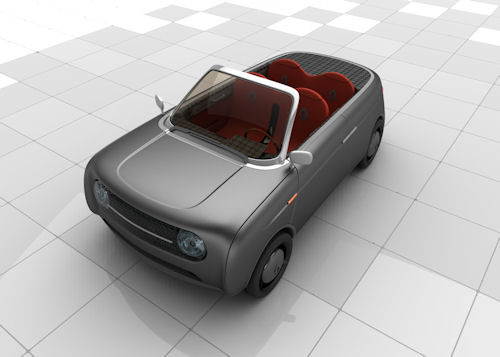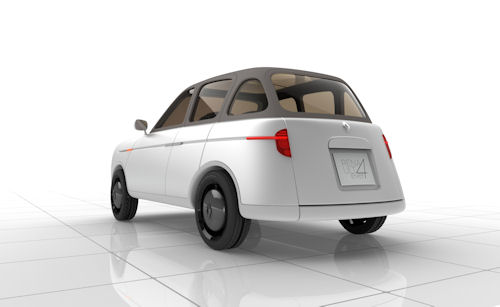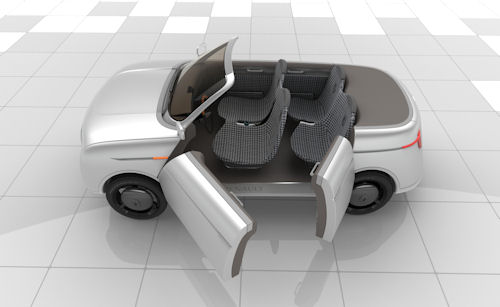Latest News
September 12, 2012
By Brett Duesing
Car culture accumulates unwritten design rules that, over time, become rote. For instance, although vehicle forms vary, they invariably communicate the same thing—either that the car can go fast, or that the truck has muscular power. The exterior must be reflective, generally with a metallic finish and chrome edging. Particularly in the U.S. market, vehicles are careful to stay within a narrow band of emotional expression, with personalities that vary from flatly serious to moderately aggressive.
The design of a suitcase, on the other hand, doesn’t carry nearly so much baggage.
To free themselves from conventional thinking, Allen Zadeh and his partner Robert Foote approached the Renault 4EVER challenge like it was a suitcase design.
“There’s no rule that says luggage has to be intimidating,” says Zadeh, who is co-founder of the Brooklyn-based design group Lovaro. Like a car, a suitcase is a companion that travels with you, and the best designs strike a balance between fashion and practicality. “People form an attachment with a piece of luggage because it’s beautiful, durable, simple to use, and feels personal.”
Can a car be designed just like other consumer products? Zadeh and Foote decided to find out.
Paris meets Brooklyn
Last fall, French automaker Renault gave out three awards in a contest to redesign its iconic hatchback model of the 1960s, the Renault 4. Lovaro was one of three winners, and the only American team recognized out of 3,000 entries worldwide.
 |
| Lovaro’s Renault 4 recreation award winner. Image by Lovaro. Rendered in KeyShot. |
Its award-winning submission is called the Eleve, meaning “student” in French. While it borrows on the form of the original Renault 4, it advances several progressive ideas like a removable roof, interchangeable components, recycled materials, and an interior concept that finds its roots closer to furniture showrooms than car dealerships.
“At the ceremony in Paris, the head design director at Renault asked me if this is the American take on the Renault 4,” Zadeh recalls. “Is this what you envision fitting into the New York City market?”
“Our main focus was staying true to the spirit of the original car,” was his answer at the time, but Zadeh admits that his environs may have subconsciously played a role: “The younger generation of urbanites “particularly in places like Brooklyn “are getting more and more design savvy.”
To the kids in Brooklyn, style and personality trump the traditional selling points of speed and horsepower. Rather than feeling materially competitive, they seek experiences that enhance their social network.
 |
| Revisiting the good feeling and simplicity of the earlier era, Lovaro was able to bring out qualities that are overlooked in today’s automotive offerings. Image by Lovaro. Rendered in KeyShot. |
“Younger people have been raised on the best of design, fashion and technology,” says Zadeh. “I think they’re looking for something new that goes beyond the current trends in auto design.”
Intrinsic Value vs. Glamour
The generation that grew up with Internet has developed a strong aesthetic sense of intrinsic value. A software app gains popularity not because of advertising hype, but by the simple fact it’s not frustrating to use. As it smoothly executes even the smallest task, it gives an impression of friendliness and affability.
U.S. car culture still relies on almost the opposite marketing formula, developed generations ago. Glamour is an external additive to the product, which has more to do with re -engineering our belief systems. Rather than simply selling the product because it integrates well with our everyday reality, glamour seeks to sell us a fantasy version of ourselves: “You are the type of person that belongs in car x.”
Lovaro as a design firm doesn’t ordinarily deal in the automotive realm, but prides itself in working across industry lines to find solutions that are straightforward and embody an honest attitude. The simplest expression of the intrinsic value of a product is generally a successful formulation of the design challenge, regardless of industry, according to Zadeh.
 |
| The Eleve is the award-winning design that updates the famous Renault 4 of the 1960s. Image by Lovaro. Rendered in KeyShot. |
“Whether we’re designing cosmetics, fashion, or personal electronics, we always try to see them in the same light in terms of attitude,” he adds. “Inevitably, the same person who buys an iPhone today, tomorrow buys a watch, eyewear or a car. These products might come from very different worlds on the industry side, but on the retail side, they all converge through the individual.”
The danger with overglamourizing a product, Zadeh warns, is that it lacks honesty. Too much glitz can backfire on a brand and be viewed as disingenuous: “It’s making a sales promise that can’t really be kept.”
Continental Drift
The roots of American car culture grew from the 1950s and ’60s, when the industry was surging with confidence. At the same time, France was still rebuilding its infrastructure of its postwar economy. The roomy, reliable and utilitarian Renault 4 was the one car within reach for many French families emerging from a decade of recession and inflation. Along with the VW Beetle and Citron 2CV, the best-selling model would define European passenger car design for the decades to come.
In the context of the times and culture, the original hatchback’s expression was not aggressive or flashy, but cute and dignified.
A Modest Proposal
An understated approach is seen in even the small considerations for the Eleve, right down to its finish: It doesn’t have one.
“In auto design, people automatically reach for super glossy finishes. We don’t really believe that should be a given,” says Zadeh. Lovaro proposed new composite plastics for the exterior panels. “What’s interesting is that these materials look beautiful in their raw form. They don’t necessarily need to be painted.”
Lovaro was careful to tone down the veneer in the presentation of the design as well. The submission illustrations were rendered in KeyShot, a CGI application that gives computer design models the professional cosmetics of car ad photography. In this case, Zadeh kept its KeyShot output intentionally low key.
“Given this was a European audience, we didn’t want too much sheen on the renderings,” he explains. “We used reflectivity instead as more of an accent on the smaller features.”
Unlike typical car ad depictions, sensually lit body surfacing is not the center of attention in the Eleve renderings. Rather, ancillary features jump out. A faint blue emissive material inside the LED headlamps gives the car a clever blue-eyed gleam. Likewise, selected spotlights on a few crafted details bring out the car’s playful character. The viewer becomes drawn toward the interior features and starts to relate to the Eleve from within a more intimate space.
Asking the Right Questions
Whether a true commercial revival of the “4” is forthcoming from Renault remains to be seen, but designers at Lovaro see a window opening for alternative thinking in automotive concepts.
Zadeh points out that by toning down the prevailing overdramatized design aesthetic, one can communicate on levels that are more personal and lasting. By refusing to rely on rote expectations and commercial hyperbole, the industry can turn toward finding new intrinsic values that directly relate to today’s consumers.
“As a designer, you have to ask how the product represents the sort of attributes that people really care about when using it “not just qualities that have been idealized over time by producers and other designers,” he concludes. “If you look at a problem carefully, you can both draw new inspiration and connect to people in a right way. In the case of the Eleve, it’s not about communicating speed or horsepower; it’s about emotional connection and enhanced relationships.”
Brett Duesing is president of Obleo Design Media. Send e-mail about this article to [email protected].
Info
Lovaro
Luxion
For more information on this topic, visit deskeng.com.
Subscribe to our FREE magazine, FREE email newsletters or both!
Latest News
About the Author
DE’s editors contribute news and new product announcements to Digital Engineering.
Press releases may be sent to them via [email protected].






